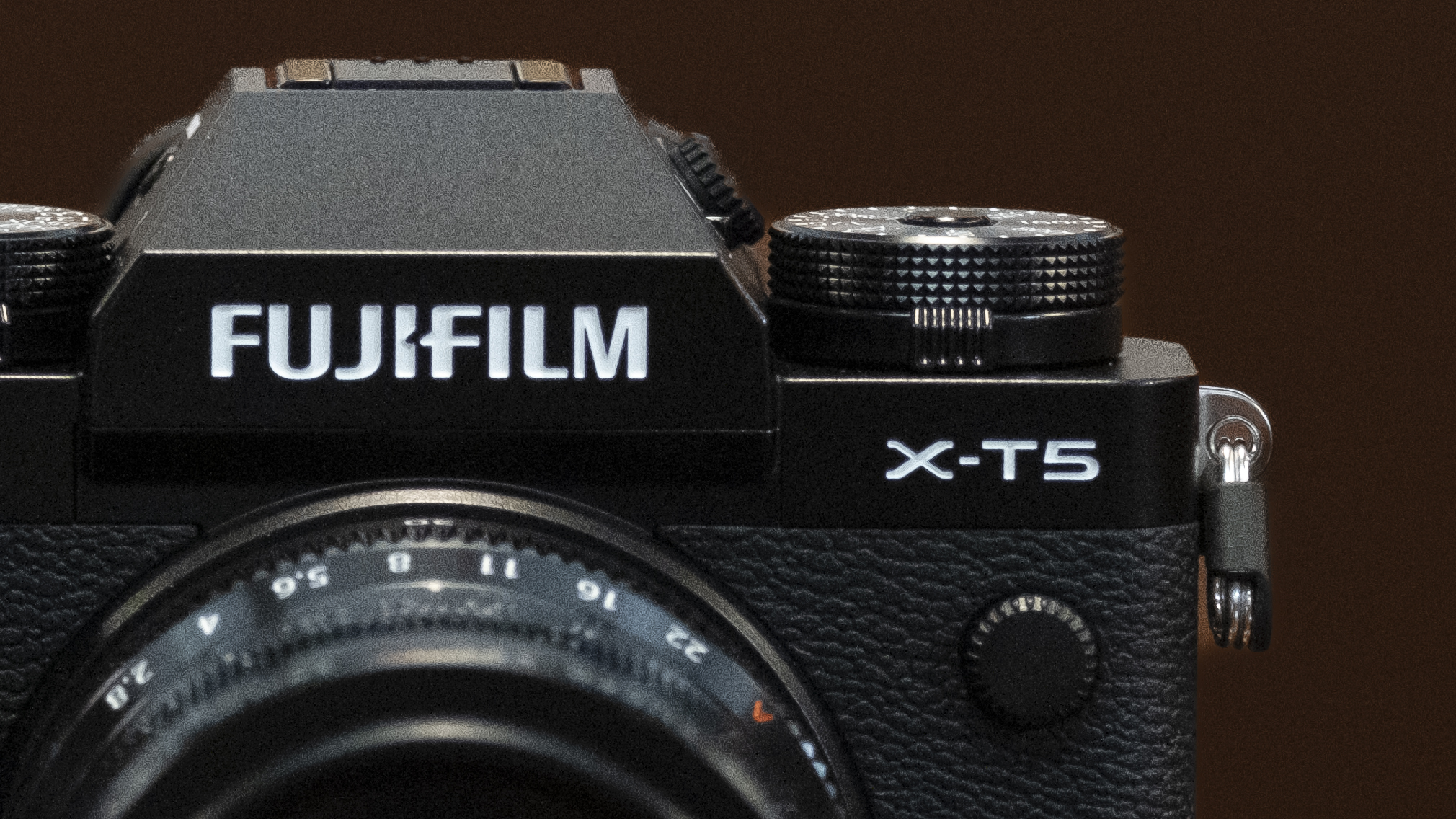Refresh
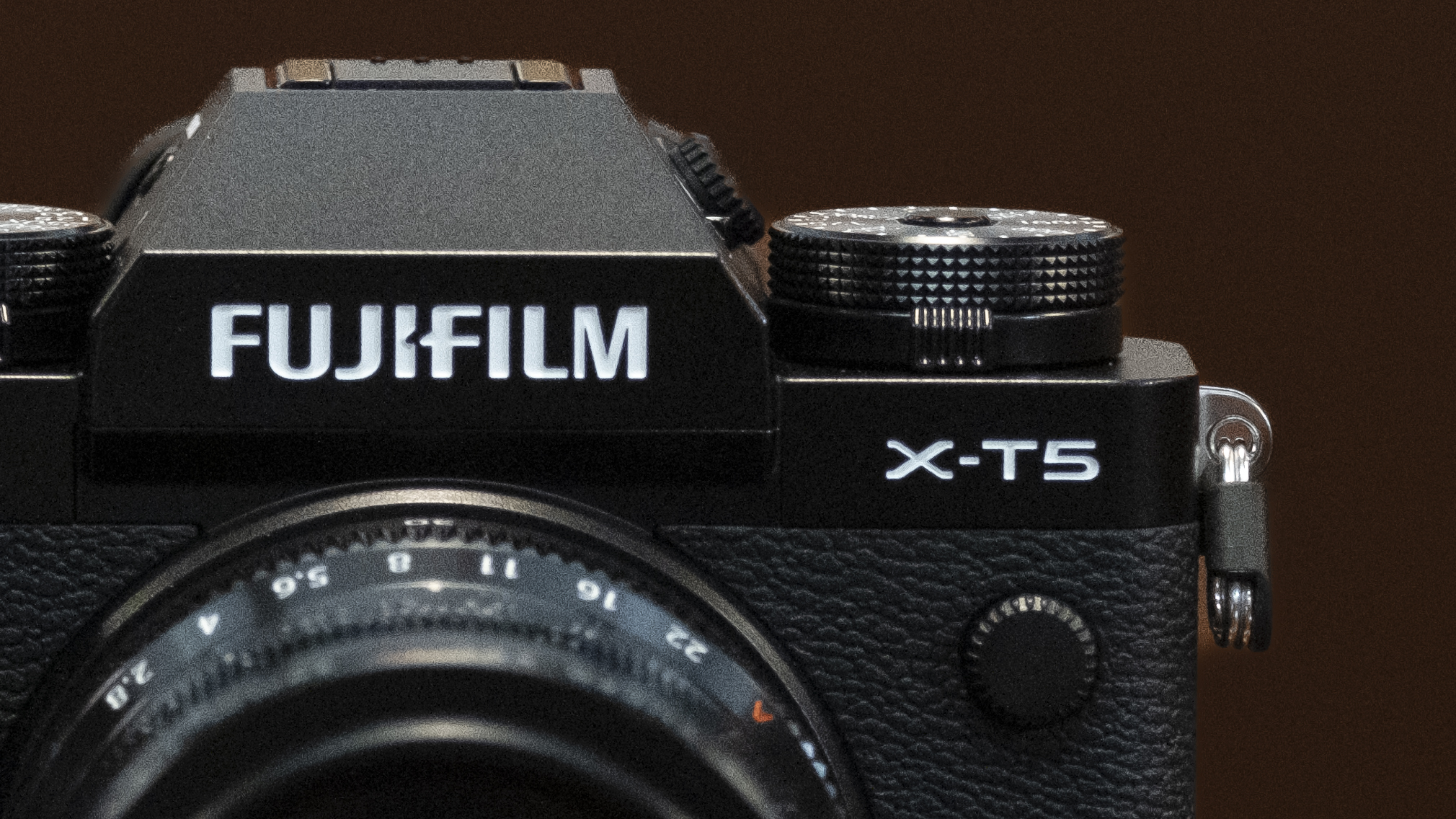
Fujifilm X-T5: early thoughts
Despite a few misgivings over its burst shooting stamina, the Fujifilm X-T5 definitely has the makings of being one of the best cameras for photography. It isn’t the most powerful mirrorless camera out there or a rival to the best hybrid cameras. But if you mostly shoot photos and prefer a tactile shooting experience with retro dials, then you’ll find it to be one of the fun and enjoyable cameras around. And that’s something that more specs-focused cameras often forget. We’ll bring you our final verdict soon, but in the meantime check out our hands-on Fujifilm X-T5 review for a closer look at this potential modern classic.

Fujifilm X-T5: the less good stuff
Every camera has compromises, so what are the Fujifilm X-T5’s? It’s definitely a more limited video camera than the X-H2, and in some ways even the X-T4. The 6.2K and 4K oversampled modes are both cropped and there’s no option of shooting 8K. You also have to put up with a flimsy microHDMI port (rather than a full-size one) and the lack of a dedicated headphone jack (though you can use a USB-C adapter).
But that’s all fine and acceptable for a photo-centric camera. My main concern’s actually the burst shooting limitations that come with being restricted to SD cards, rather than the CFexpress you find on the X-H series. Because the X-T5 needs to push through 40MP of detail with each frame, it can’t maintain continuous shooting for very long.
The specs below show the X-T5’s continuous shooting buffers when you use its mechanical shutter. Whatever frame-rate you pick, you’re effectively limited to a maximum of 2-3 seconds of burst shooting with uncompressed raws. You can extend that by going for lossless compressed raw and 7fps, but it’s something to bear in mind – the X-T5 is certainly more suited to landscapes than sports or action.
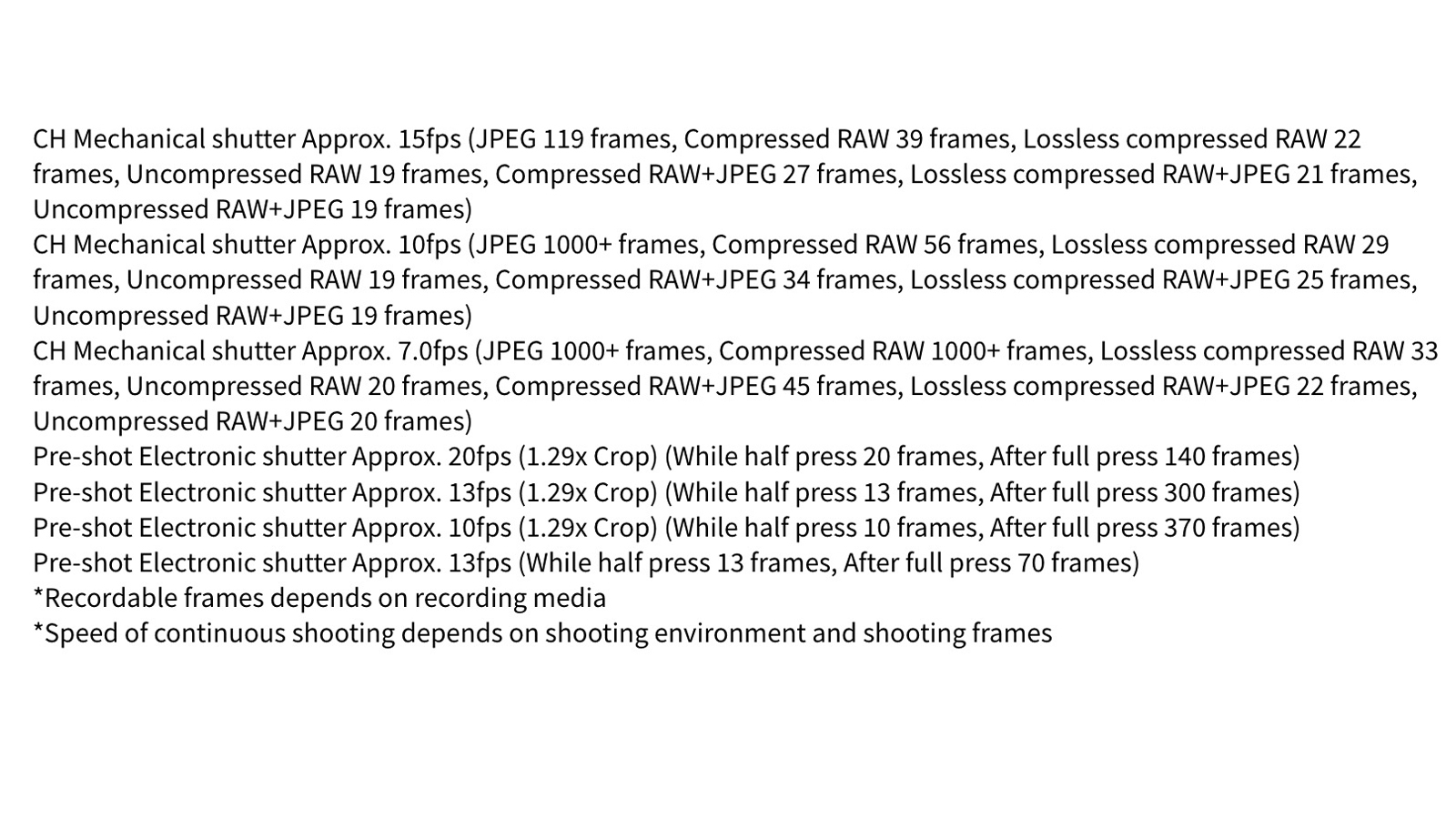
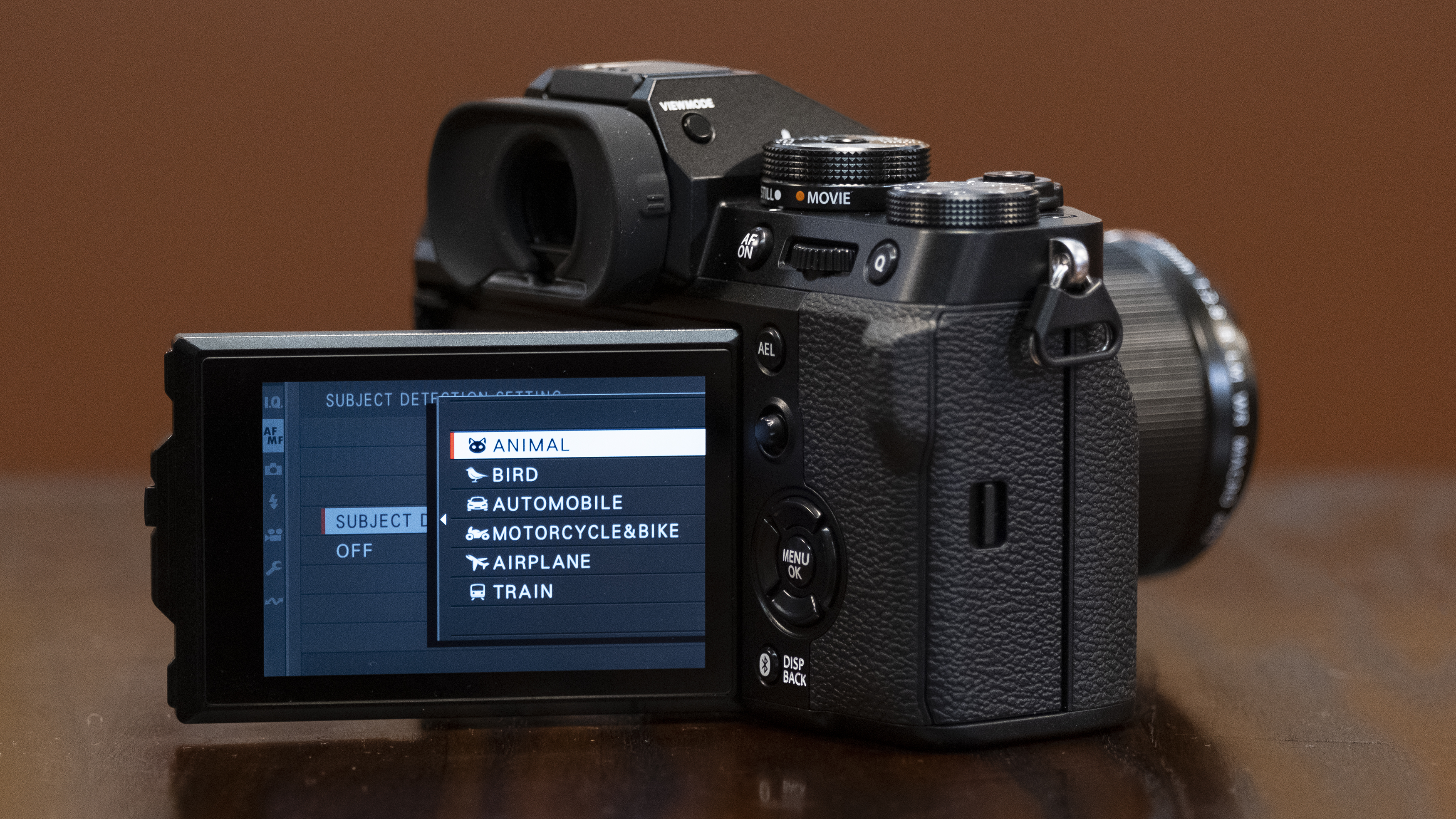
Fujifilm X-T5: the good stuff
There’s definitely a lot to like about the Fujifilm X-T5, particularly if you mainly shoot photos rather than video. Its 40MP APS-C sensor and X-Processor 5 are the same as the ones in the X-H2, and that’s very good news. It’s the most powerful combo you can find outside of full-frame flagships or the X-H2S.
That extra resolution is a bonus for detail and cropping. There also isn’t too much of a downside in terms of noise or dynamic range, and you get Fujifilm’s latest subject-tracking autofocus system. If you’re upgrading from an older X-T series camera (an X-T3 or earlier), you’ll also definitely appreciate the in-body image stabilization.
I’m really glad that the X-T5 has brought back the three-way tilting screen from the X-T3, rather than the increasingly common fully articulating design. It’s just a lot more convenient for shooting from high or low angles, and the X-H2 series is there if you need a hybrid-style body with a screen that flips round to the front.
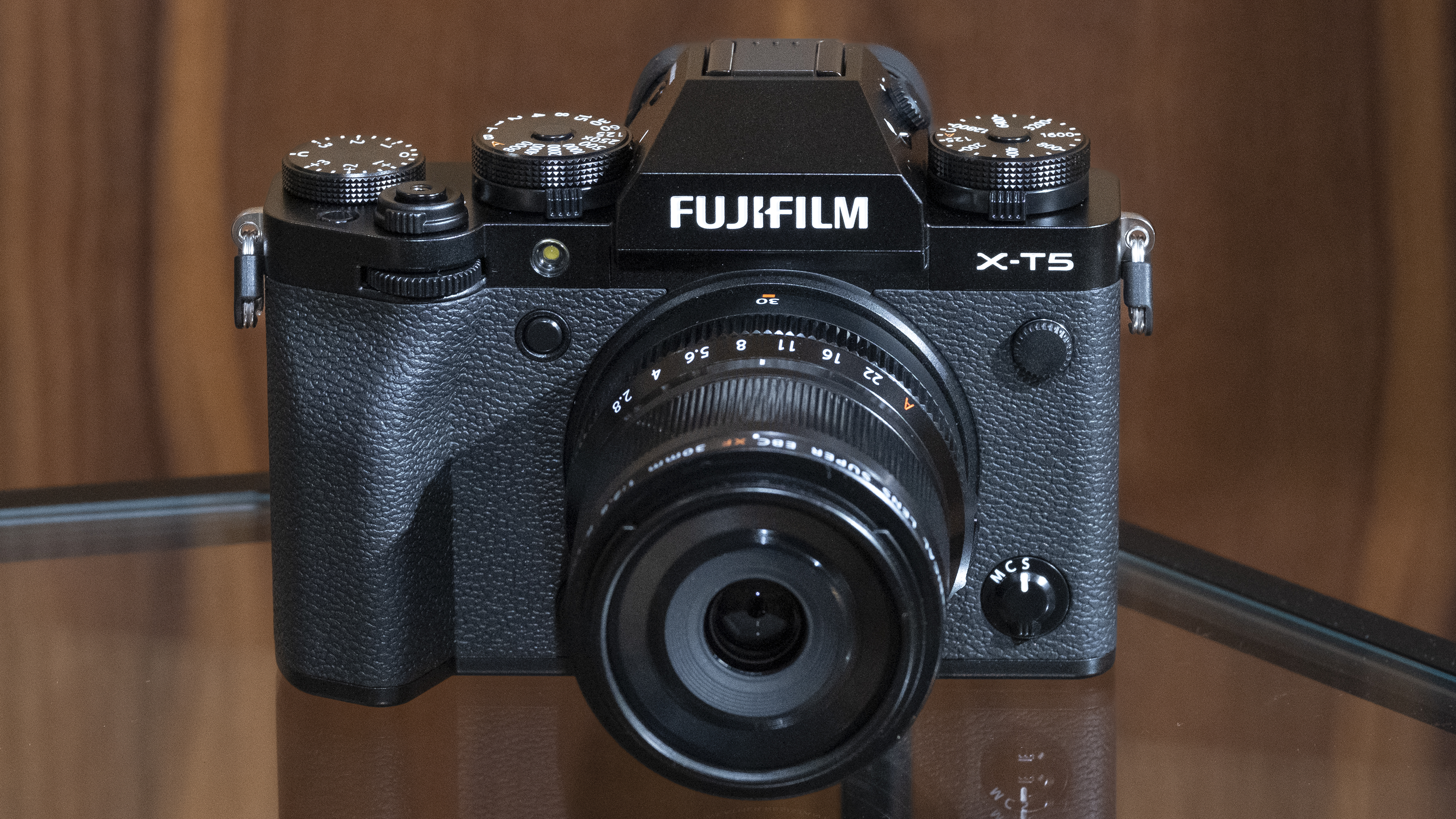
Fujifilm X-T5 first impressions
I managed to get hands-on with a final production Fujifilm X-T5 here in London (yep, that was quick). You can read all of my early thoughts at our hands-on Fujifilm X-T5 review.
But if you’re settled and comfortable here in this liveblog, I’m going to round up some of my early thoughts in here, too. The TL;DR version: the XT-5 is really great, but there’s just one thing that’s slightly bugging me.
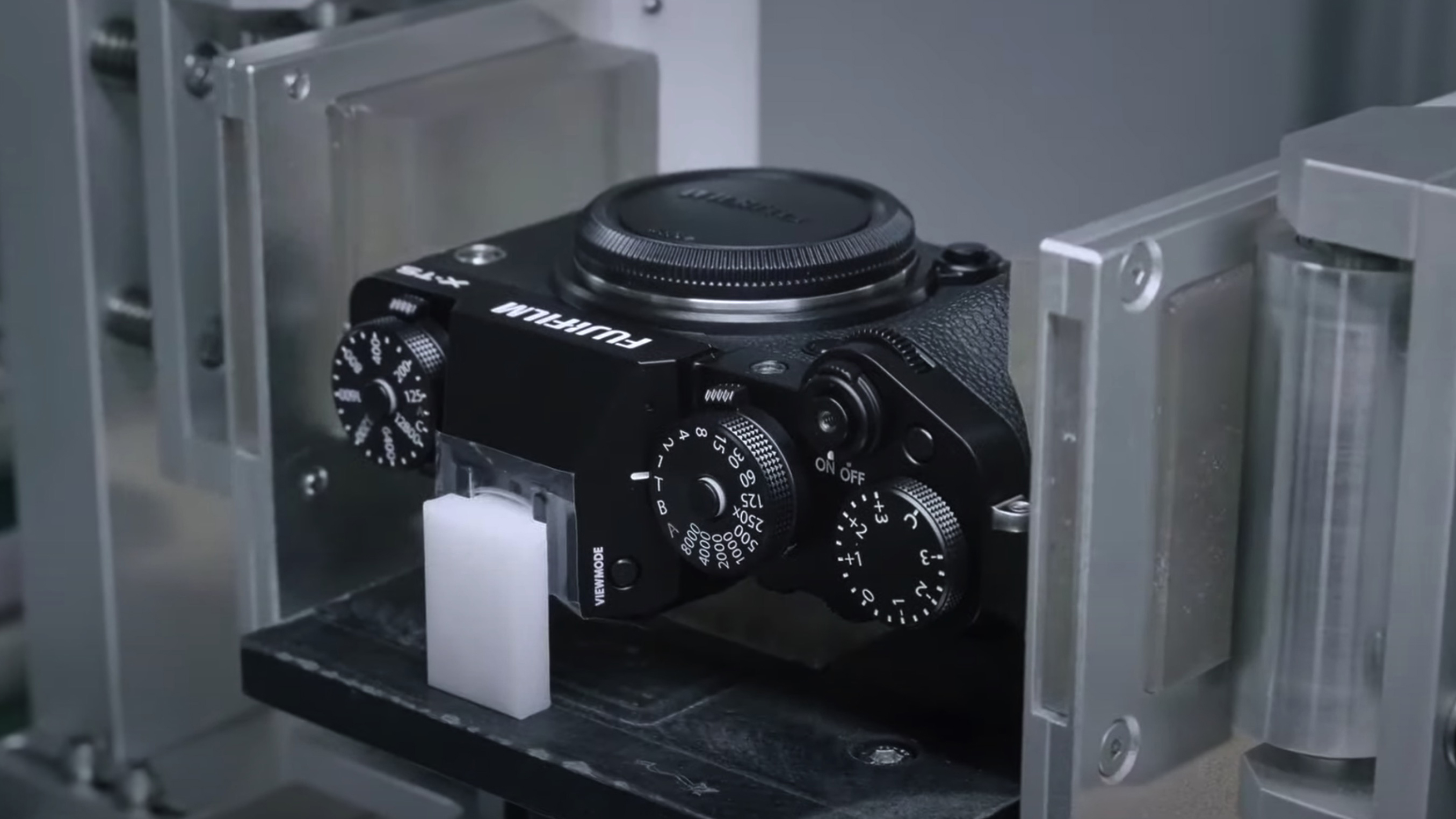
And that’s a wrap for this third Fujifilm X Summit of the year. On paper, the Fujifilm X-T5 is definitely one of the year’s most exciting cameras – so stick around on this liveblog as we’ll be assembling some early thoughts about it very soon.
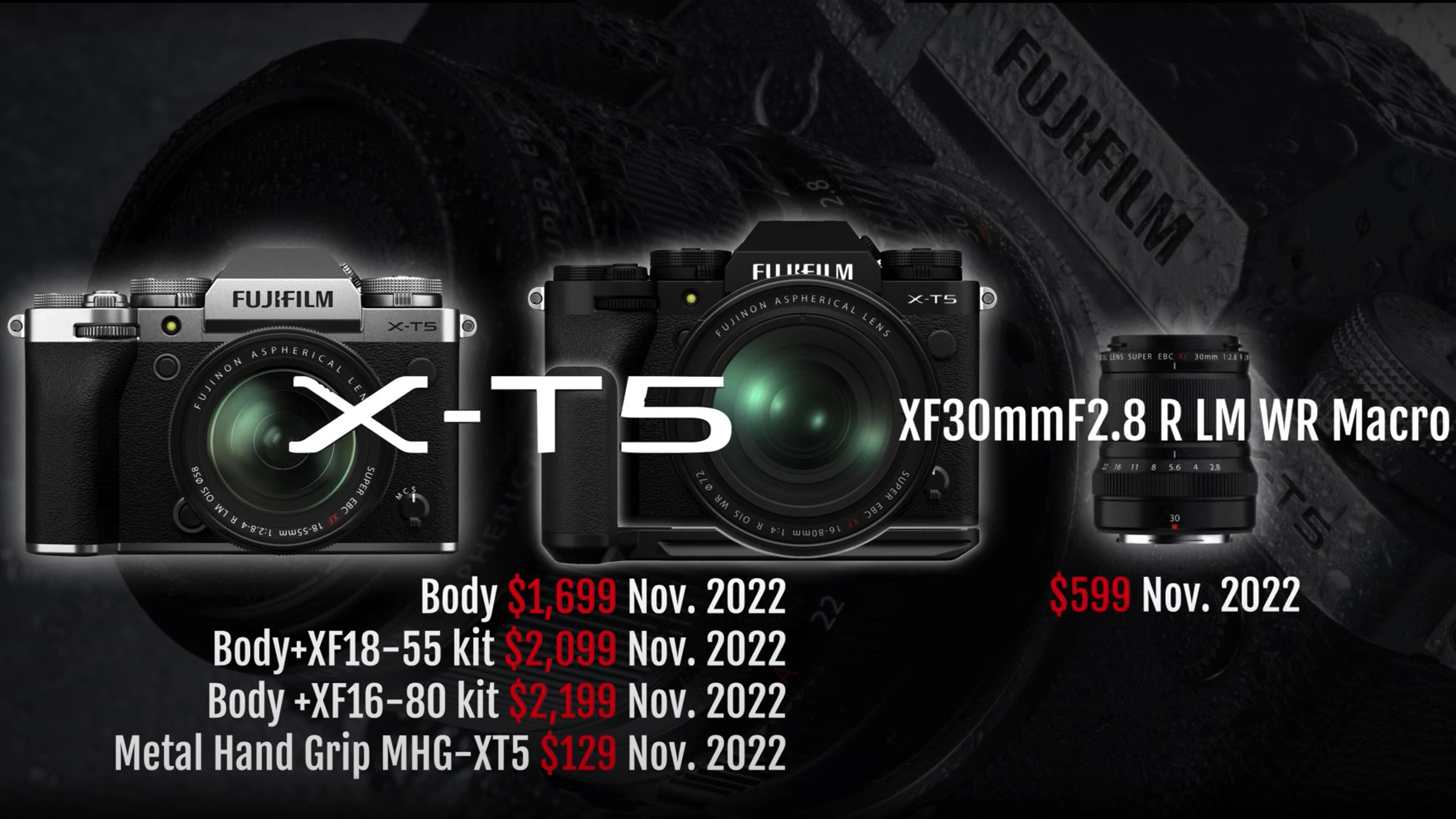
And here is that official pricing for the X-T5 and the new XF30mm f/2.8 R LM WR lens in US dollars. We’re just working on getting some pricing for other territories, but that’s exactly the same as the launch price for the Fujifilm X-T4. Pretty impressive.
Considering worldwide inflation since then, plus the X-T5’s new sensor, processor and other features, I’m glad Fujifilm’s managed to keep the camera at its mid-range price.
As if anticipating the demand, Fujifilm has shown its factory busily preparing X-T5 shipments – it says “at the earliest, they will be available in two weeks”. Best get over to that pre-order page if you’re interested, then.
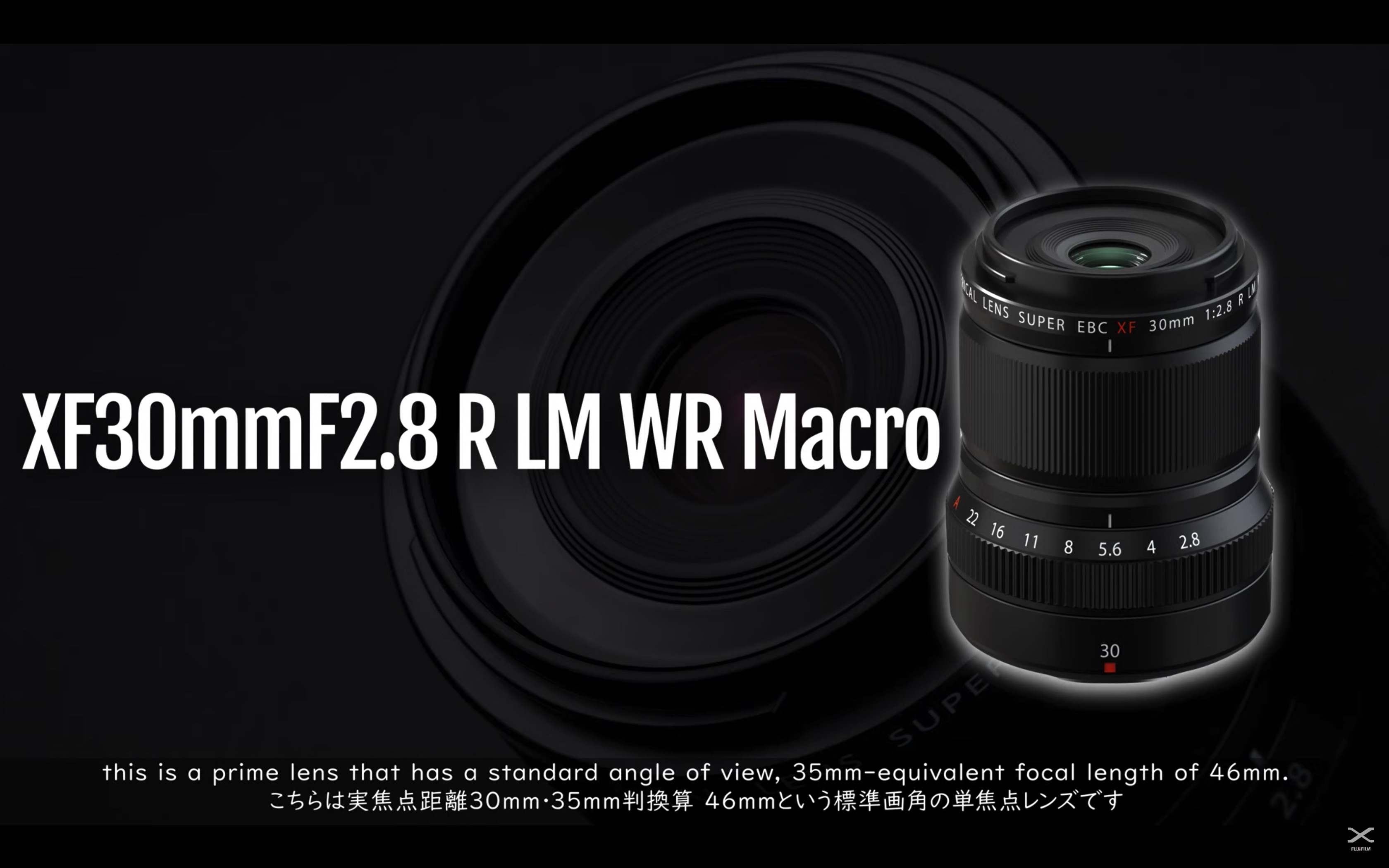
Moving on from the X-T5, we have a new XF30mm f/2.8 R LM WR Macro lens. It has a full-frame equivalent focal length of 46mm and sounds very versatile, with a handy minimum focusing distance of 10cm. It also has a linear motor drive. Now just to find out about pricing…
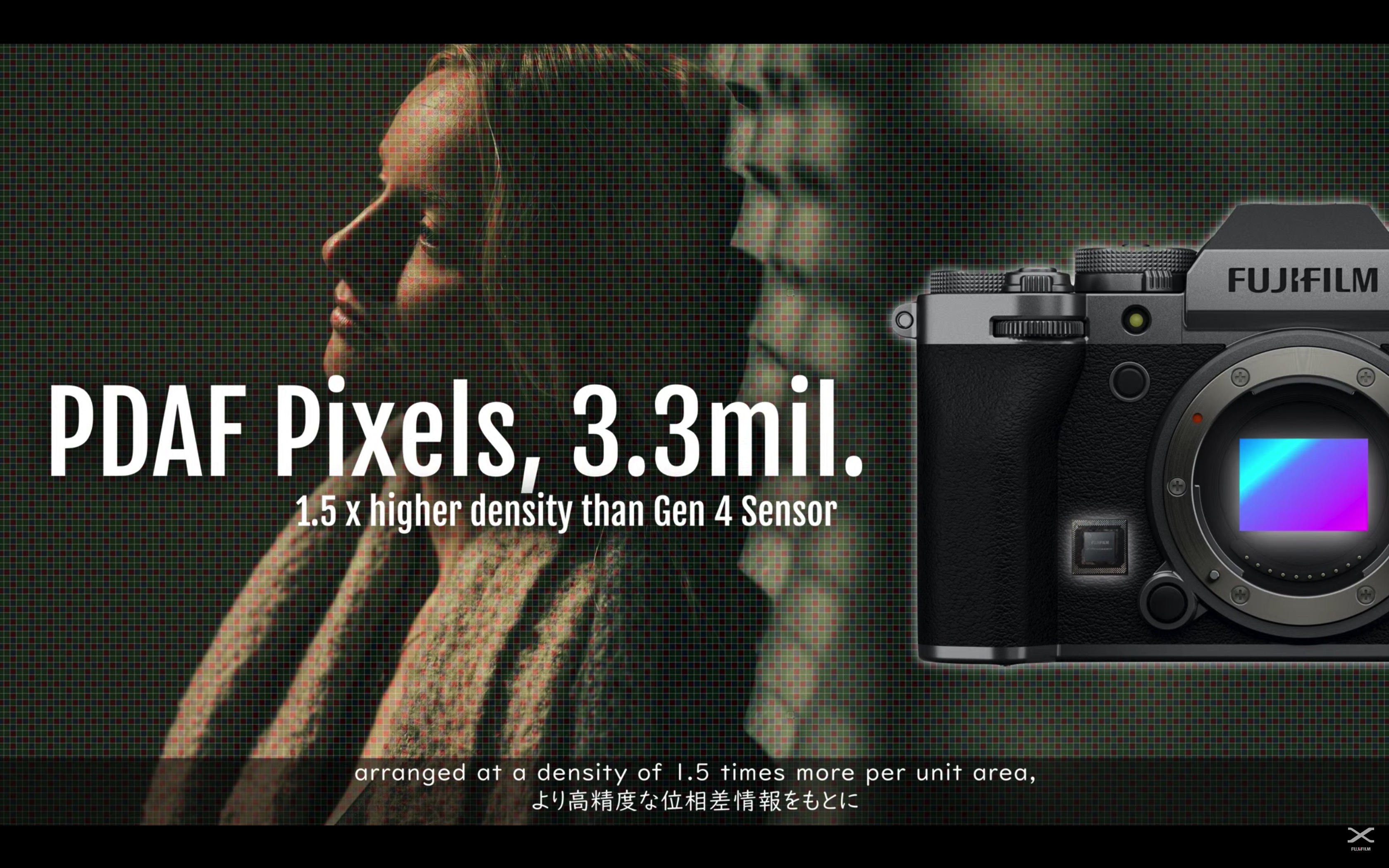
And now Fujifilm’s talking about autofocus. It claims there will be a noticeable improvement from the X-T4’s AF performance, because it has a 1.5x higher density of PDAF (or phase-detect) pixels than its predecessor’s sensor.
That sounds promising, but autofocus is as much about algorithms as hardware – so we’re looking forward to seeing how that compares to the likes of the Canon EOS R7 soon.
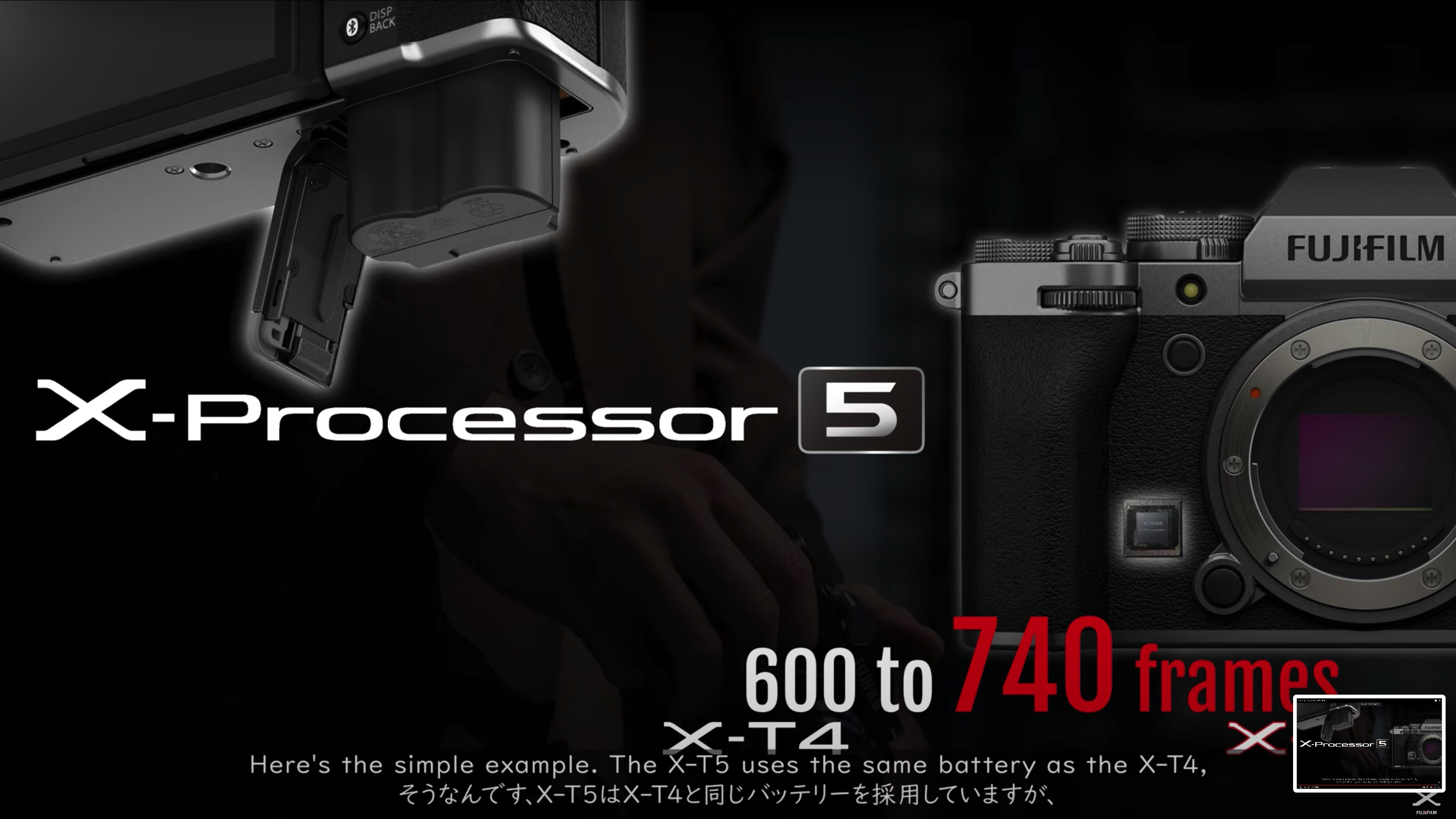
Moving onto processors now. The X-Processor 5 apparently brings other benefits beyond AF improvements – it also has a power-saving design that boosts the X-T5’s battery life up to 740 frame (in economy mode), from 600 frames on the X-T4. That’s a nice quality-of-life upgrade, it not hugely different from its rivals.
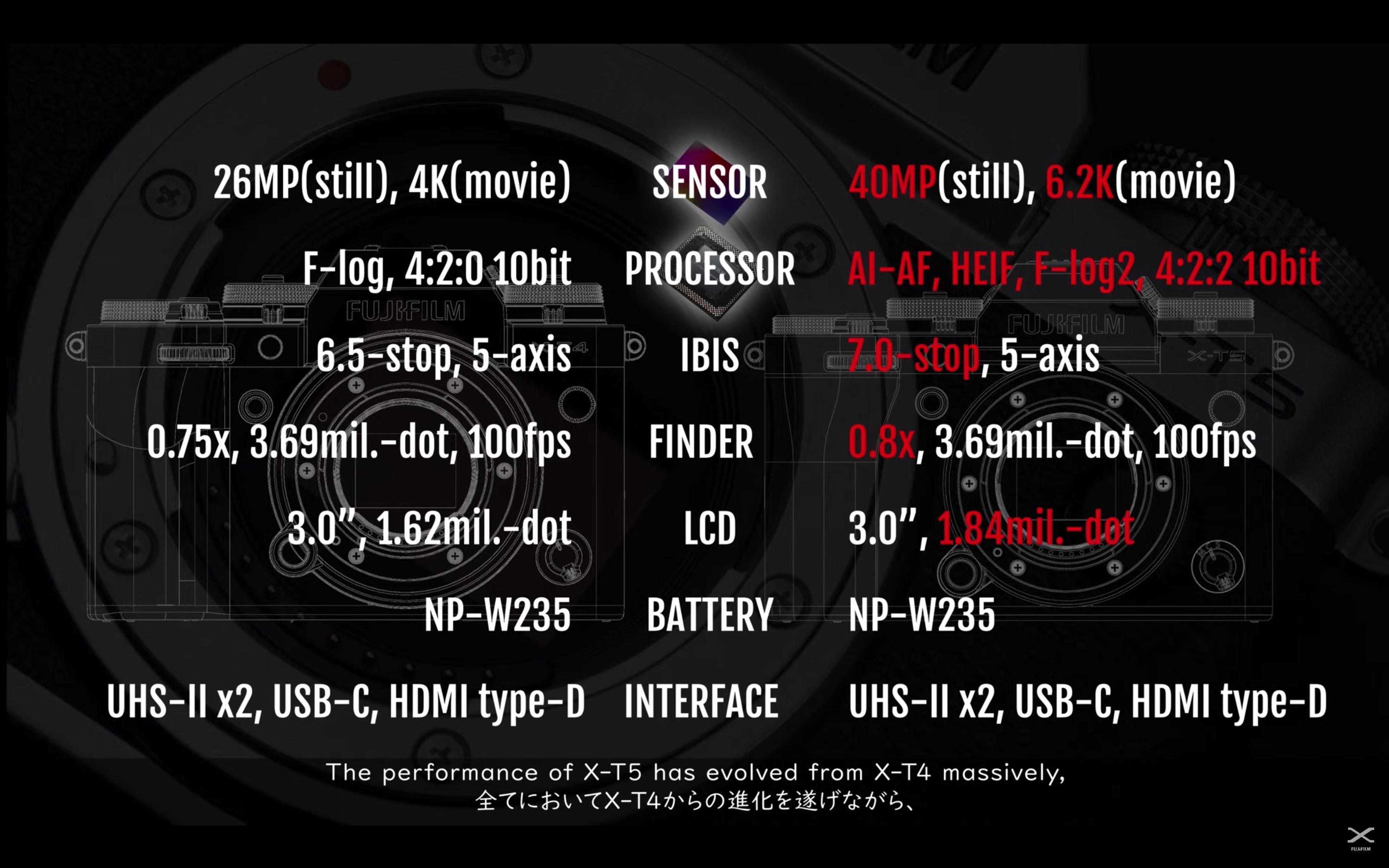
Ooh, here’s a good specs comparison with the X-T4. It’s a pretty big internal upgrade, and Fuji claims the image quality improvements aren’t just about resolution – its processing apparently improves tonal variation and film-like colors. There’s also the benefit of 10-bit HEIF files, which are the natural successors to JPEG (while also being helpfully smaller).
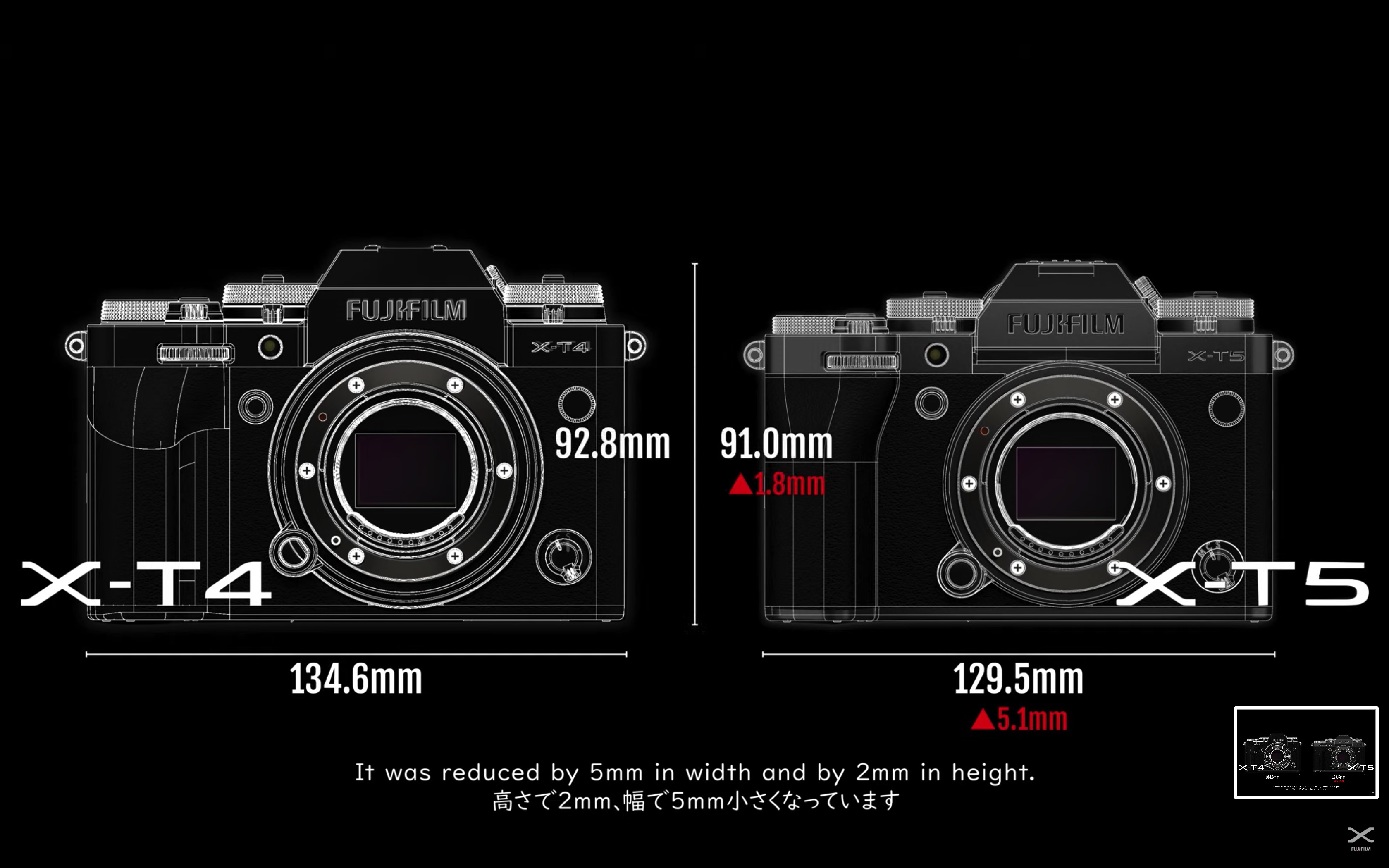
Fujifilm says the X-T5 has gone down “one size” compared to its predecessor. It’s more like the size of an X-T1, the first camera in the series, and is 50g lighter than the X-T4. All very nice, but unlikely to make a dramatic difference to your shooting experience.
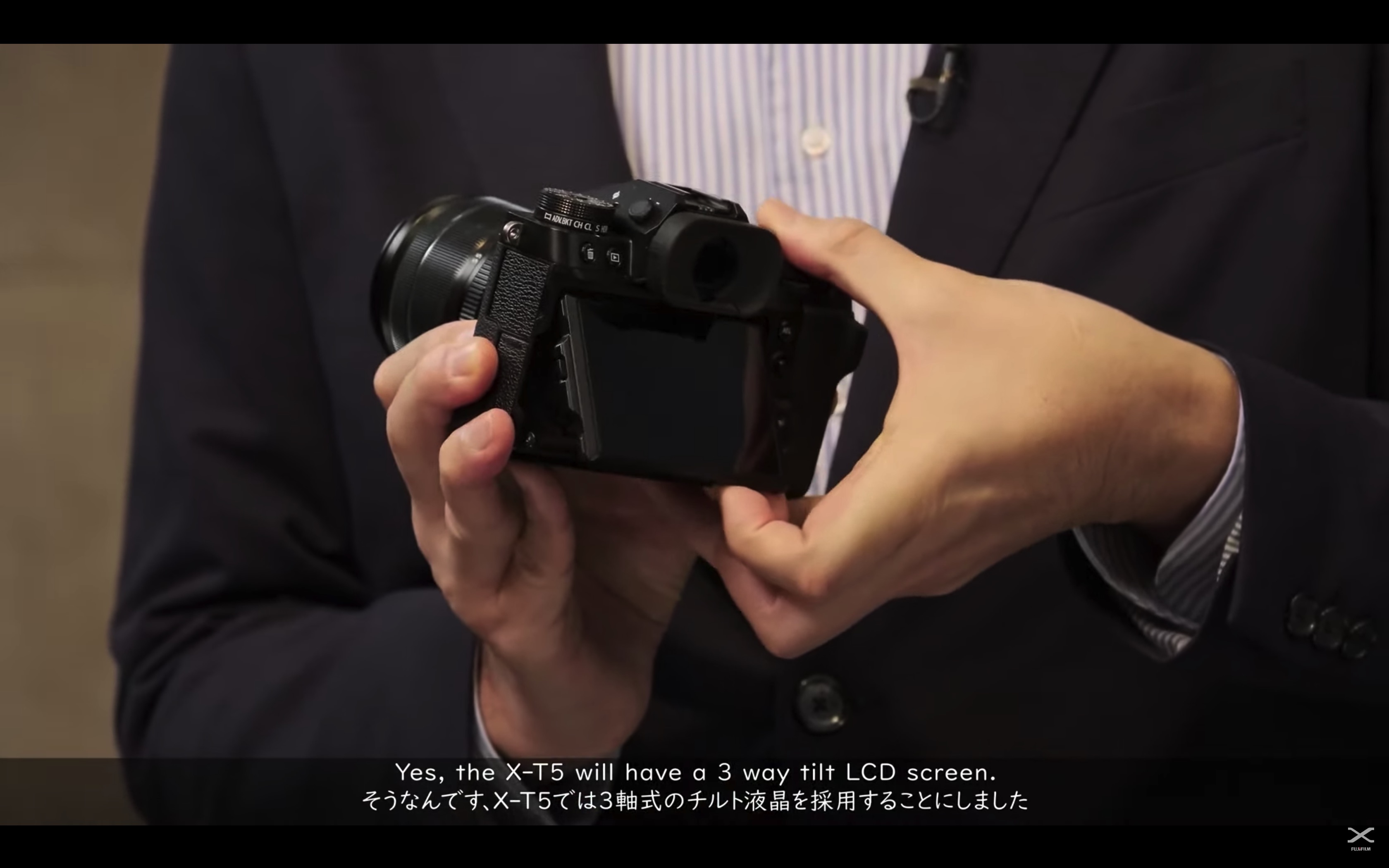
Photographer Kevin Mullins (also of the FujiCast podcast) now talking about the design of the X-T5. He’s a fan of the three-way tilting screen, which is the case among most photography-focused Fuji shooters.
He plans to use it for everything from weddings to everyday shooting, and also notes that the focusing switch on the front (for changing between manual and continuous focus) is crucial for when shooting with your eye to the viewfinder. That was missing on the X-H series.
Something that hasn’t been covered yet, though, is how long the X-T5’s burst shooting can be maintained for – which could be crucial for wedding or action snappers.
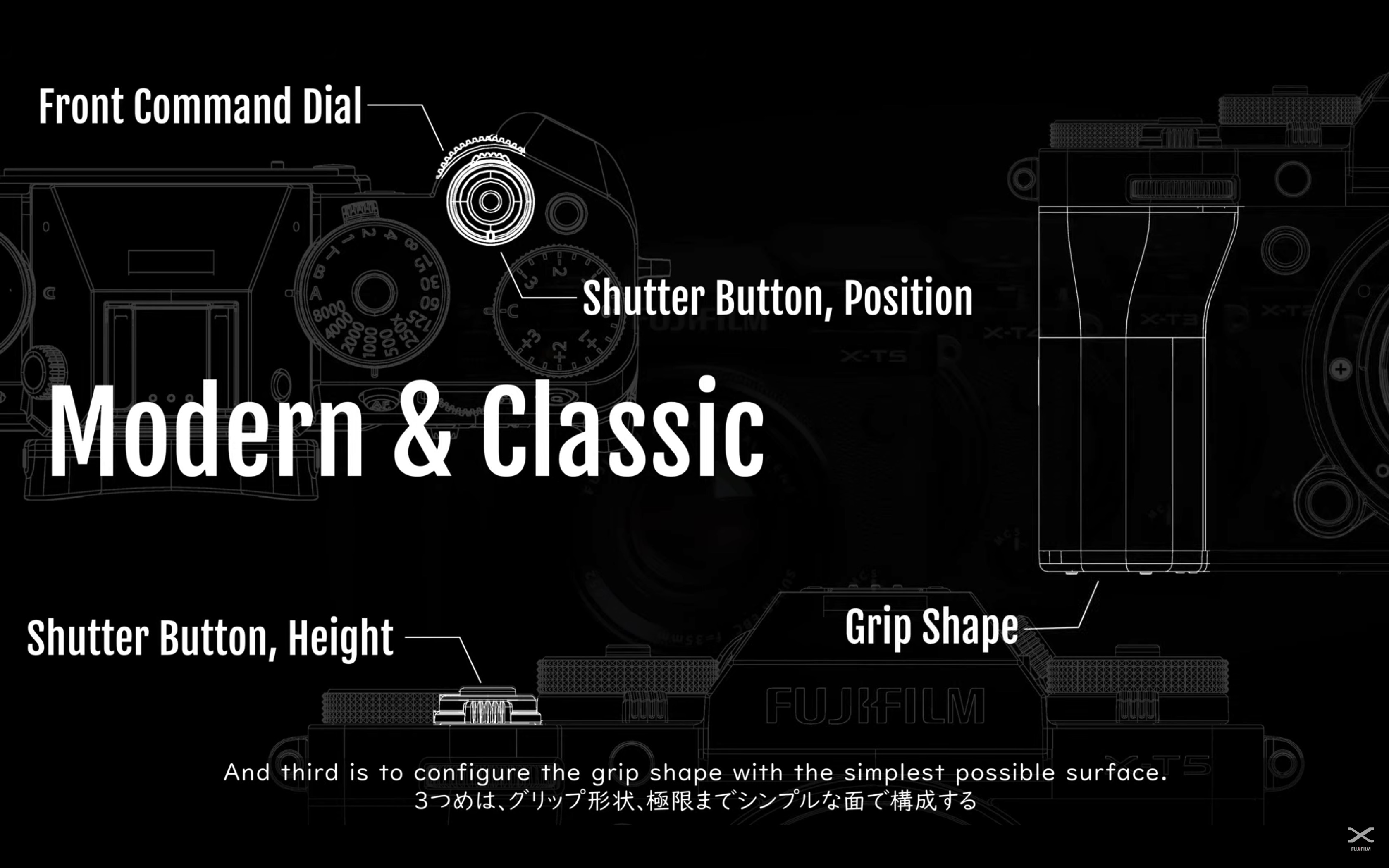
Three physical changes from the X-T4: the shutter button’s’s been moved back a bit, the shutter height’s been adjusted, the grip shape is slightly different.
Nothing dramatic here, but they all seem like sensible refinements.
Jun Watanabe, Fujifilm Product Planner, is speaking about the X-series cameras. He’s focusing on the distinctive controls of the X-series — and confirmed that the X-T5 will stick with that design, giving it standalone ISO, shutter speed and exposure compensation dials, as opposed to the PASM format of the X-H2 and X-H2S. Great news.
OK, and the big news is that the Fujifilm X-T5 is official!
Anyway, it’s 1pm GMT, so we’re live. Let’s find out what Fujifilm has in store for us…
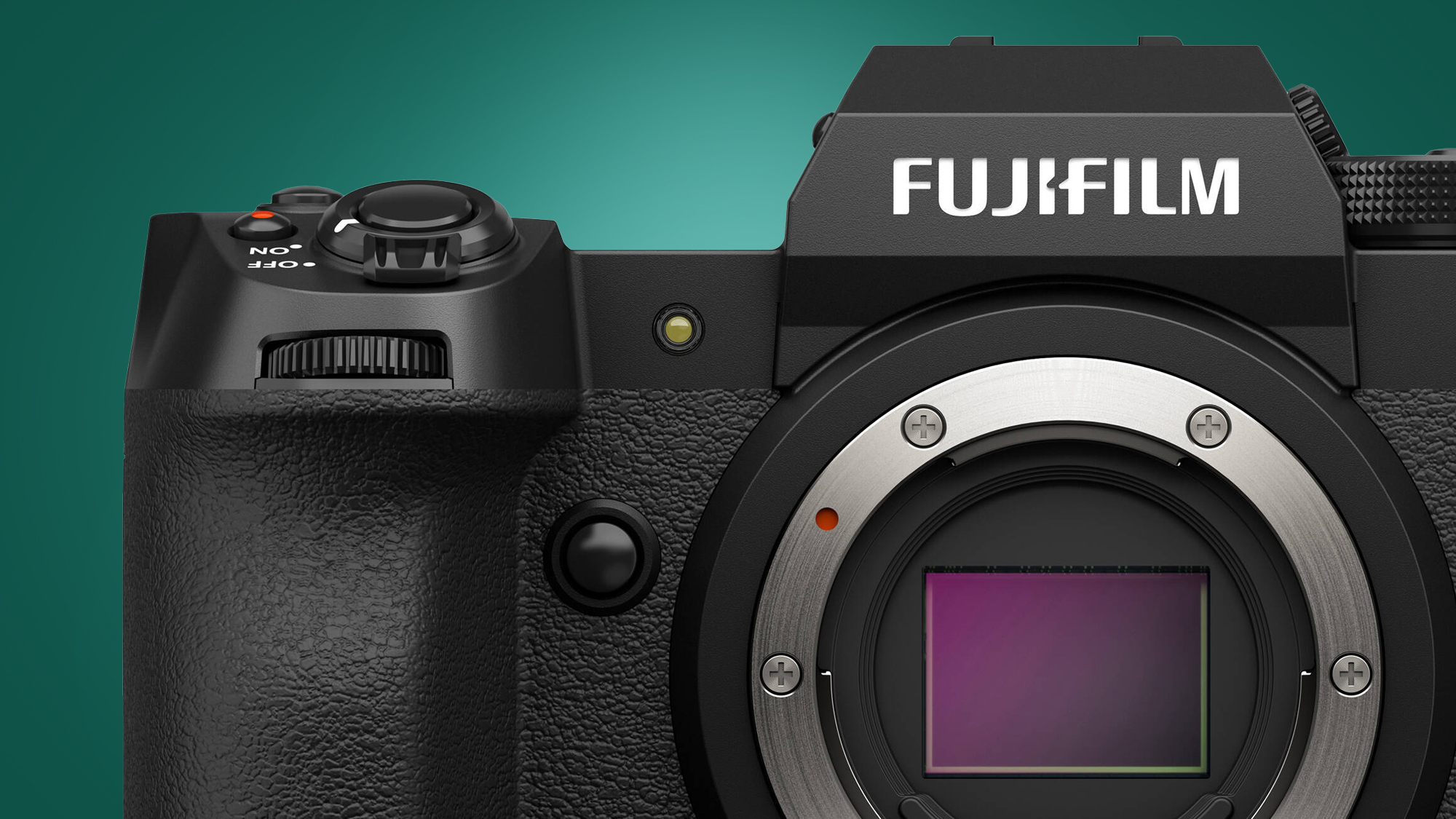
Sticking with price, the X-H2 (above) sells for $1,999 / £1,899 / AU$3,399 in body-only form, whereas the X-H2S costs $2,499 / £2,499 / AU$4,449 — that’s no surprise, as stacked sensors are more expensive to manufacture.
With most rumors pointing to the X-T5 getting the 40MP sensor, rather than the 26MP option, I’m hopeful that the new model will match the X-T4’s original price tag of $1,699 / £1,549 / AU$2,999.
If it does have the stacked sensor, that price could creep up towards or even above the $1,999 range, which would leave me with rather a difficult decision to make. I’d much rather have the 40MP sensor than the 26MP one, because I shoot mainly landscape, portrait and macro, where the extra megapixels would be welcome. But at the same time, I don’t really want to swap to the X-H2’s PASM design; I like my manual controls.
Essentially, please don’t make me choose between sensor and controls, Fuji!
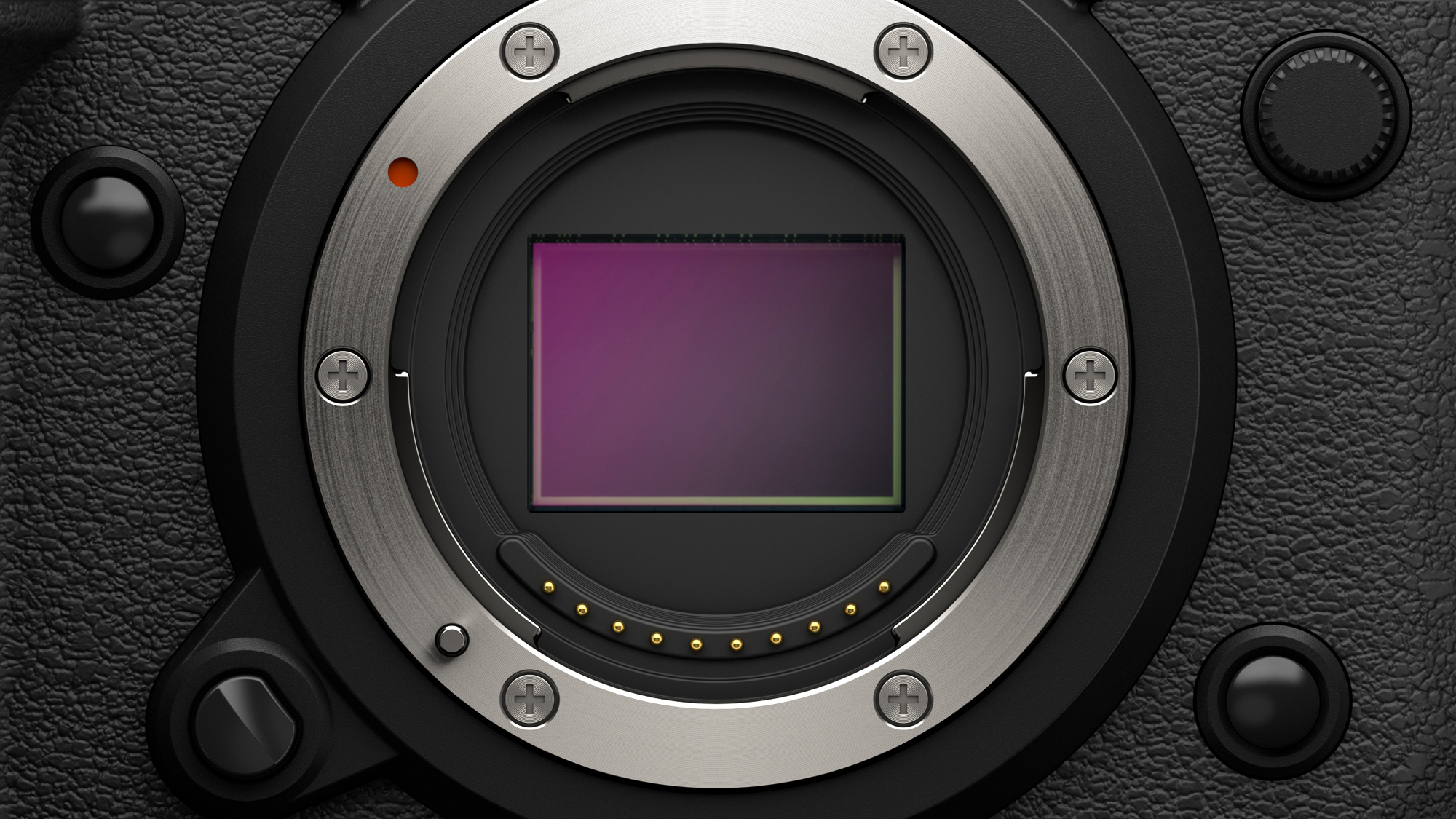
So, what’s the deal with this sensor? Well, as keen Fuji watchers will know, Fujifilm has already released two new cameras this year, the Fujilm X-H2 and the Fujifilm X-H2S.
The first of these has a new back-illuminated 40.2MP X-Trans CMOS 5 HR sensor inside it, which we can say from experience takes amazing photos.
The H2S, meanwhile, has another new sensor – but this one is a stacked 26MP X-Trans CMOS 5 HS APS-C chip. This delivers incredibly fast read-out speeds, bringing benefits for video and autofocus.
The X-T5, if it is indeed revealed today, will almost certainly get one of these two new sensors — the question is which one. Our money’s on the 40.2MP sensor, and that bodes well for the X-T5’s potential price tag…
Hello, TechRadar UK Editor in Chief Marc McLaren here to look after this live blog for an hour.
I’ve been a Fujifilm shooter for nearly a decade now, starting with the X-T1 way back in January 2014. But I can honestly say I’ve never been as excited about the launch of a new Fuji camera as I am for (hopefully) the arrival of the X-T5.
Why? Well, partly it’s because I’m currently using the X-T3, which has served me very well but which lacks the in-body image stabilization that’s found in the X-T4 and will presumably be inside the X-T5 too. But it’s also due to the rumors that the X-T5 will get a lovely new 40MP sensor (opens in new tab).

Fujifilm X Summit: a wishlist
With just over an hour until the X Summit kicks off, it’s time to round up my hopes for the event. Clearly, a Fujifilm X-T5 looks pretty likely based on the leaks, at that would be hard to top as a headline – I recently argued that it has the potential to be the year’s most exciting camera.
But this is an X Summit, and not just a product launch. So what other news would make for a good supporting lineup? Here’s what I’d like to see:
– a new Fujifilm app. Earlier this year there were rumors that Fujifilm was about to fix the worst thing about its mirrorless cameras: its smartphone app. Since then, nothing. But a new app that connects to X-series camera like a bit quicker than a 90s dial-up connection would be lovely.
– a refreshed X-mount lens roadmap. Getting new 40MP cameras like the X-H2 is lovely, but not all of Fuji’s lenses can take advantage of that resolution. It’d be great to hear about more about which ‘Mark II’ lenses are coming next down Fuji’s pipeline for 2023.
– a teaser for the X-Pro4 or X-T40. This may be too much to ask for, but it’d be great to get a glimpse of where Fuji’s smaller cameras are going with its next-generation sensors and processors. Stretch goal: a Fujifilm X100V with a 35mm f/2 equivalent lens.
– a guest appearance from Michael Bay. No particular reason, just think it could the X Summit could do with a few explosions to finish off.
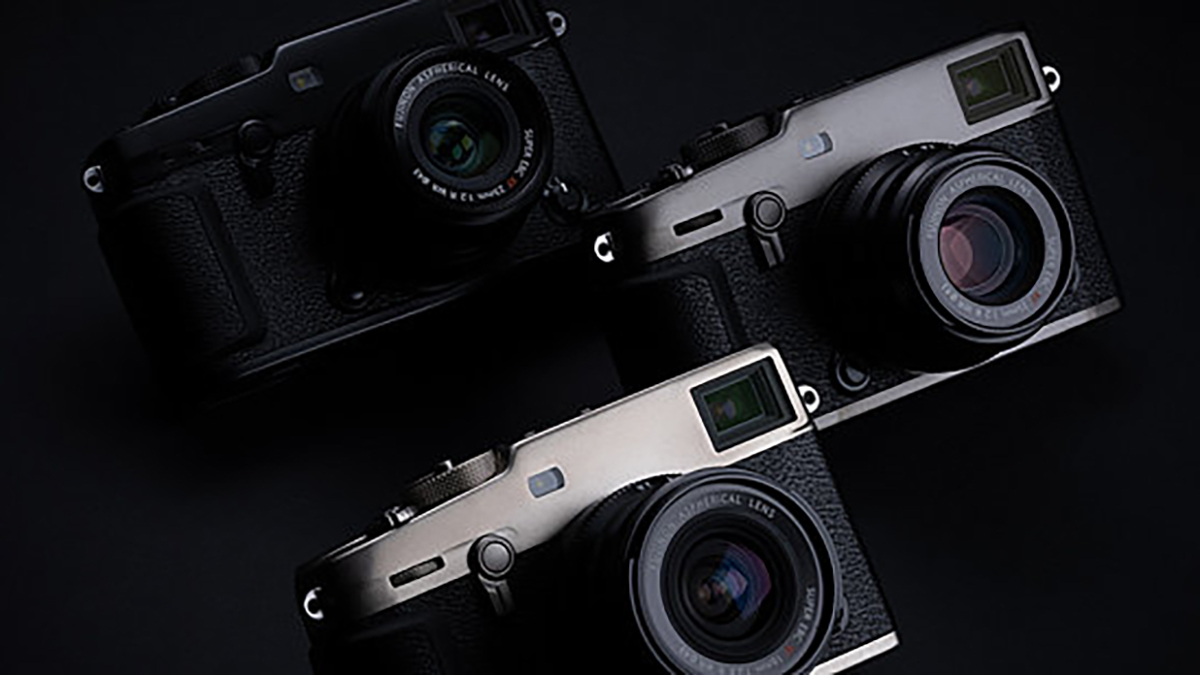
What about other X-Series cameras?
Based on recent leaks, a Fujifilm X-T5 does look pretty likely for today’s X Summit. But while that’s pretty exciting, I’m as interested in what Fujifilm says (if anything) about the rest of its X-series lineup.
An Apple-style ‘one more thing’ is now increasingly an X Summit tradition, with Fuijfilm teasing both the X-H2 and X-H2S at last year’s event. So could we hear about what it plans to do with its popular X-Pro (above) and X-T double-digit cameras?
Both are very popular with street and travel photographers, and there’s now a tried-and-tested 40MP APS-C sensor out in the wild…
A treat for macro fans?
It looks like we now have an inkling of something other than the rumored X-T5 that might appear at the X Summit later – a new macro lens.
Fuji Rumors (opens in new tab) has picked up what appear to be some leaked photos of a new XF30mm f/2.8 R LM WR Macro lens. Fujifilm does already have a couple of macro lenses in its lineup, including the XF 80mm f/2.8 R LM OIS WR Macro, but this one could be a smaller, cheaper alternative that doubles as a handy companion for everyday shooting.
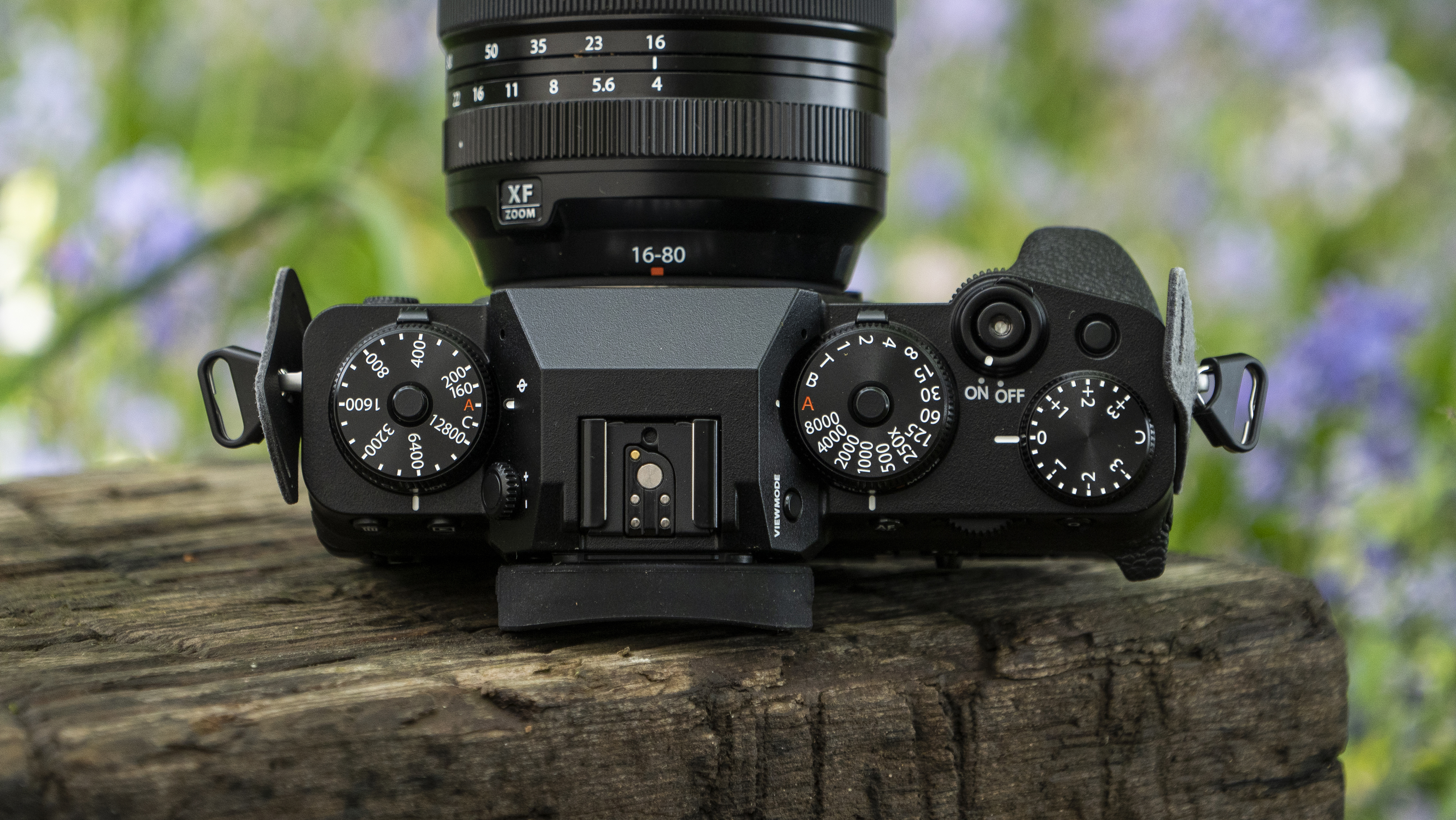
The X-Series in a nutshell
Let’s zoom out a bit and take a look at where Fujifilm’s X-series sits in today’s camera world. The range is built around APS-C sensors, which are larger than Micro Four Thirds but smaller than full-frame. While this means X-series cameras don’t gather as much light as a camera like Sony A7 IV, the overall system size is smaller than full-frame – and that’s made it particularly popular with street and landscape shooters.
Most Fujifilm cameras also embrace physical dials for changing settings like shutter speed and ISO, which harks back to old film cameras. Aside from retro looks, this gives them a tactile shooting experience that relies more on dials and aperture rings than touchscreens and menus.
Recent cameras like the Fujifilm X-H2S and X-H2 have adopted a more traditional PASM (Program, Aperture, Shutter, Manual) approach, though, so it’ll be interesting to see what Fujifilm says about this if we do indeed get that rumored X-T series camera today.
Update: the video’s been taken down
We still don’t officially know what’s launching today (or how many new products we’ll see), but there are certainly some big clues surfacing online this morning.
One of those is, well, what appears to be a first look video (above) with the rumored Fujifilm X-T5 (as picked by Fuji Rumors (opens in new tab)). It certainly looks like Roberts Camera in the US has had a facepalm moment and got its scheduling wires crossed, so that video will almost certainly mysteriously disappear soon.
But the odds of us seeing a Fujifilm X-T5 later certainly just rose quite substantially. And that’s potentially dangerous news for anyone who’s trying to resist buying a new camera this year (including me).
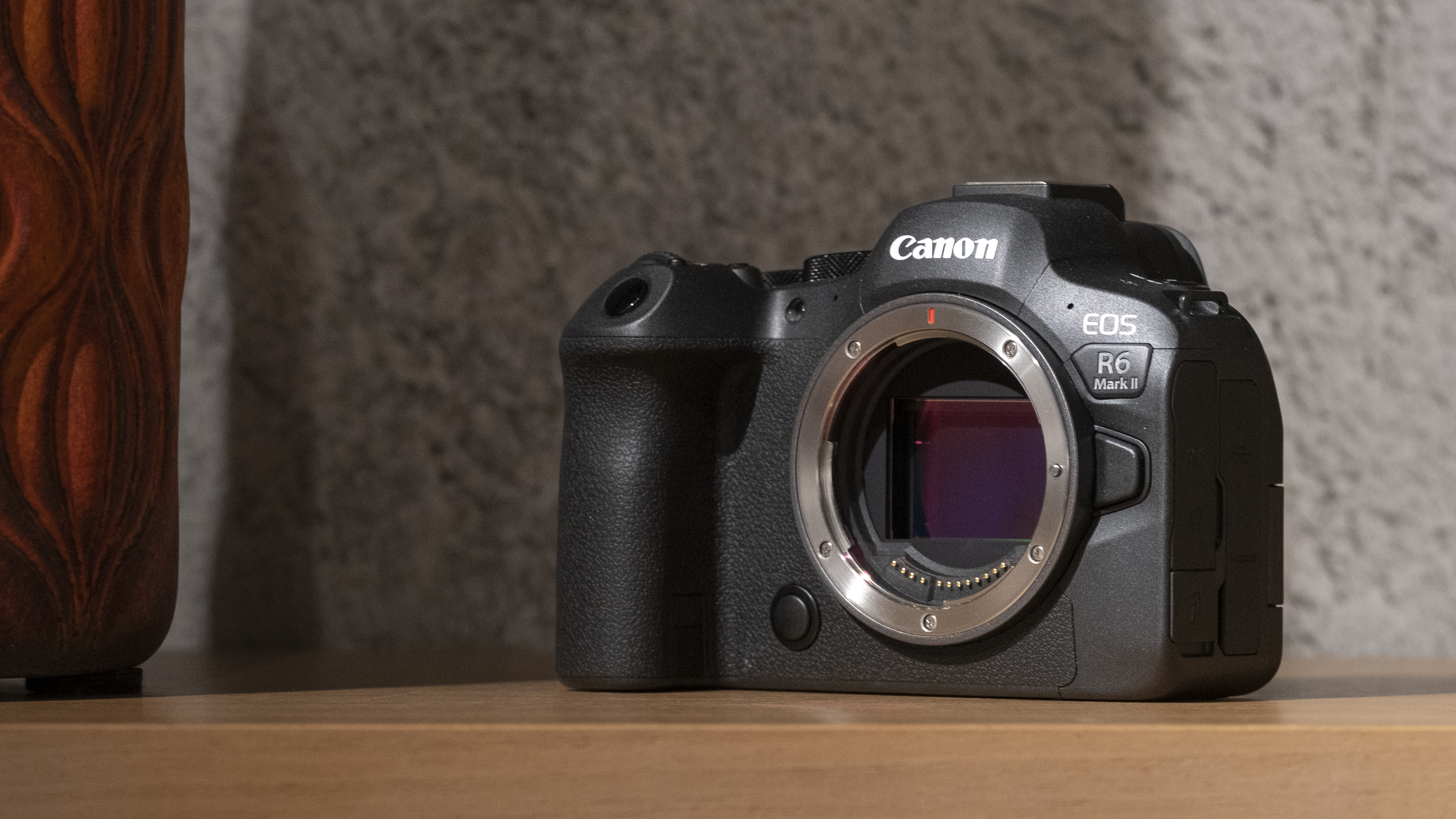
It’s raining cameras
A quick bit of non-Fujifilm news before we delve into the X Summit: Canon has just announced the Canon EOS R6 Mark II, an update to its popular full-frame mirrorless camera from 2020. Yes, it’s raining camera news today.
The headline addition is a jump from its predecessor’s slightly paltry 20MP sensor to a new 24.2MP one. Even though this sensor doesn’t have a ‘stacked’ design, it is speedy enough to support 40fps burst shooting (touché, says the Fujifilm X-H2S) and some uncropped, oversampled 4K/60p video.
It’s a really quite compelling all-rounder that you can pre-order for $2,499 / £2,779 / AU$4,499. Want to know our early thoughts? Check out our hands-on Canon EOS R6 Mark II review. And now, back to Fujifilm…
There’s already an impressively high number of Fuji fans camped out on the X Summit’s livestream page. And it seems virtually everyone has a different wishlist for today’s announcement.
Among the early comments are hopes for “a new X100 series” (Fujfilm’s popular street photography compacts), an “X-Pro4 with that new 40MP sensor please”, and the most heavily rumored contender, the “X-T5”. No pressure then, Fuji…

Why are X Summit events a big deal in the camera world? Historically, they’ve been more than just single product announcements – we typically also get to see new lenses and some teasers for future launches, too.
During Fujifilm’s X Summit in June 2021, for example, we saw two new cameras and eight new lenses announced (four for the X-Series, and four for the medium format GFX series). Fuji also revealed that its next generation of X-Trans sensors would include a speedy stacked design – which ultimately turned out to be the one inside flagship Fujifilm X-H2S.
I can’t promise that many announcements today, but there’s definitely precedent for a few surprises. And buckle up, because that event was an hour long.
So, how do you actually watch today’s Fujifilm X Summit? The event’s being livestreamed on YouTube at the link above, with the official start time being November 2 at 9am EST / 1pm GMT. If you’re in Australia, that works out as 12am AEDT on November 3, but that’s no excuse not to tune in.
YouTube handily lets you set reminders for when livestreams are about to kick off –just hit the bell icon on the video above and you’ll get an email reminder. But the better approach is clearly to grab some popcorn plus your favorite camping chair, and follow our build-up here. It’ll definitely be a lot more entertaining than watching Twitter get burnt to the ground.
Hello, I’m Mark (TechRadar’s Cameras editor) and I’ll be guiding you through today’s Fujifilm X Summit event. I’ve used, reviewed and owned a lot of Fujifilm X-series cameras, so I’m really looking forward to seeing what the unique camera brand has up its sleeves for today.
It’s already been a cracking end to the year for new cameras, with the OM System OM-5, Hasselblad XQD 100C and Sony finally springing into life with the FX30, ZV-1F and A7R V. I played with the latter last week and it’s shaping up to be one of the cameras of the year. Could Fujifilm actually manage to upstage it today? We’ll find out it in just over ten hours.
